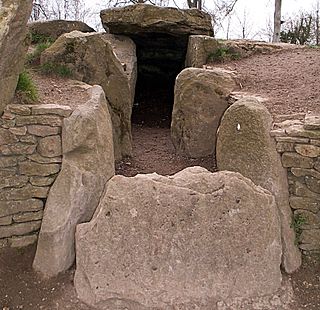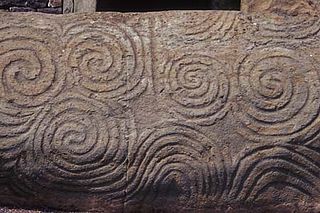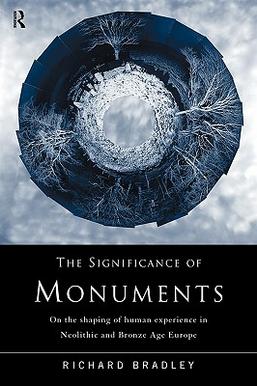
A petroglyph is an image created by removing part of a rock surface by incising, picking, carving, or abrading, as a form of rock art. Outside North America, scholars often use terms such as "carving", "engraving", or other descriptions of the technique to refer to such images. Petroglyphs, estimated to be 20,000 years old are classified as protected monuments and have been added to the tentative list of UNESCO’s World Heritage Sites. Petroglyphs are found worldwide, and are often associated with prehistoric peoples. The word comes from the Greek prefix petro-, from πέτρα petra meaning "stone", and γλύφω glýphō meaning "carve", and was originally coined in French as pétroglyphe.

A stone circle is a ring of standing stones. Most are found in Northwestern Europe – especially in Britain, Ireland, and Brittany – and typically date from the Late Neolithic and Early Bronze Age, with most being built from 3000 BC. The best known examples include those at the henge monument at Avebury, the Rollright Stones, and elements within the ring of standing stones at Stonehenge. Scattered examples exist from other parts of Europe. Later, during the Iron Age, stone circles were built in southern Scandinavia.

The Cotswold-Severn Group are a series of long barrows erected in an area of western Britain during the Early Neolithic. Around 200 known examples of long barrows are known from the Cotswold-Severn region, although an unknown number of others were likely destroyed prior to being recorded.

Megalithic art refers to art either painted or carved onto megaliths in prehistoric Europe. Elizabeth Shee Twohig has coined the term Megalithic art in her study of 'The Megalithic Art of Western Europe'. Her original definition of Megalithic art focused on paintings or carvings found on the structural elements, like the kerbstones, orthostats, or capstones of megalithic tombs, but recent investigations have included decorations on stelae and menhirs.

Cup and ring marks or cup marks are a form of prehistoric art found in the Atlantic seaboard of Europe (Ireland, Wales, Northern England, Scotland, France, Portugal, and Spain – and in Mediterranean Europe – Italy, Azerbaijan and Greece, as well as in Scandinavia and in Switzerland.

Long Meg and Her Daughters is a Neolithic stone circle situated north-east of Penrith near Little Salkeld in Cumbria, North West England. One of around 1,300 stone circles in the British Isles and Brittany, it was constructed as a part of a megalithic tradition that emerged during Neolithic, and continued into the Early Bronze Age. The stone circle is the third widest in England, behind Avebury in Wiltshire, and only slightly smaller than Stanton Drew in Somerset.

Little Meg is a small circle of large kerb stones which probably surrounded a Bronze Age kerb cairn. It is close to the village of Langwathby to the north-east of Penrith in the English county of Cumbria and is 650 metres north-east of the more famous stone circle of Long Meg and Her Daughters. It forms part of a complex of stone circles and cairns around the Long Meg site that includes the circle at Glassonby, Old Parks, and other sites since lost.

In archaeology, the term entoptic phenomena relates to visual experiences derived from within the eye or brain. In this respect they differ slightly from the medical definition, which defines entoptic phenomena as only applying to sources within the eye, not the brain. To avoid this confusion, the term subjective visual phenomena is sometimes used. Entoptic was chosen by author David Lewis-Williams due to its origin from Greek meaning "coming from within".

Bronze Age Britain is an era of British history that spanned from c. 2500–2000 BC until c. 800 BC. Lasting for approximately 1,700 years, it was preceded by the era of Neolithic Britain and was in turn followed by the period of Iron Age Britain. Being categorised as the Bronze Age, it was marked by the use of copper and then bronze by the prehistoric Britons, who used such metals to fashion tools. Great Britain in the Bronze Age also saw the widespread adoption of agriculture.

The rock drawings in Valcamonica are located in the Province of Brescia, Italy, and constitute the largest collections of prehistoric petroglyphs in the world. The collection was recognized by UNESCO in 1979 and was Italy's first recognized World Heritage Site. UNESCO has formally recognized more than 140,000 figures and symbols, but new discoveries have increased the number of catalogued incisions to between 200,000 and 300,000. The petroglyphs are spread on all surfaces of the valley, but concentrated in the areas of Darfo Boario Terme, Capo di Ponte, Nadro, Cimbergo and Paspardo.

The Neolithic period in the British Isles lasted from c. 4000 to c. 2,500 BCE. Constituting the final stage of the Stone Age in the region, it was preceded by the Mesolithic and followed by the Bronze Age.

Cathole Cave, Cat Hole Cave or Cathole Rock Cave, is a cave near Parc Cwm long cairn at Parc le Breos, on the Gower Peninsula, Wales. It is a steep limestone outcrop, about 200 yards (180 m) north of the cromlech along the Parc le Breos Cwm valley and near the top of the gorge, about 50 feet (15 m) from the valley floor. The cave is a deep triangular fissure penetrating the hillside and narrowing towards the top. It has two entrances, with a natural platform outside the larger of the two. It is about seven 1⁄2 miles (12 km) west south–west of Swansea, Wales, in what is now known as Coed y Parc Cwm at Parc le Breos, on the Gower Peninsula.

The stone circles in the British Isles and Brittany are a megalithic tradition of monuments consisting of standing stones arranged in rings. These were constructed from 3300 to 900 BCE in Britain, Ireland and Brittany. It has been estimated that around 4,000 of these monuments were originally constructed in this part of north-western Europe during this period. Around 1,300 of them are recorded, the others having been destroyed.

Rock art has been produced in Europe since the Upper Palaeolithic period through to recent centuries. It is found in all of the major regions of the continent. One of the most famous examples of parietal art is the Grotte Chauvet in France. The cultural purpose of these remnants of the Paleolithic and other periods of prehistoric art is not known. However, some theories suggest that, because these paintings were created in parts of the caves that were not easily accessed, it is unlikely that they were intended simply as decoration.

The architecture of Scotland in the prehistoric era includes all human building within the modern borders of Scotland, before the arrival of the Romans in Britain in the first century BCE. Stone Age settlers began to build in wood in what is now Scotland from at least 8,000 years ago. The first permanent houses of stone were constructed around 6,000 years ago, as at Knap of Howar, Orkney and settlements like Skara Brae. There are also large numbers of chambered tombs and cairns from this era, particularly in the west and north. In the south and east there are earthen barrows, often linked to timber monuments of which only remnants remain. Related structures include bank barrows, cursus monuments, mortuary enclosures and timber halls. From the Bronze Age there are fewer new buildings, but there is evidence of crannogs, roundhouses built on artificial islands and of Clava cairns and the first hillforts. From the Iron Age there is evidence of substantial stone Atlantic roundhouses, which include broch towers, smaller duns. There is also evidence of about 1,000 hillforts in Scotland, most located below the Clyde-Forth line.

The Significance of Monuments: On the Shaping of Human Experience in Neolithic and Bronze Age Europe is an archaeological book authored by the English academic Richard Bradley of the University of Reading. It was first published by Routledge in 1998.

The Shap Stone Avenue is a megalithic complex near Shap in Cumbria, England, comprising stone circles, a two-mile avenue of stones, and burial mounds.

Prehistoric art in Scotland is visual art created or found within the modern borders of Scotland, before the departure of the Romans from southern and central Britain in the early fifth century CE, which is usually seen as the beginning of the early historic or Medieval era. There is no clear definition of prehistoric art among scholars and objects that may involve creativity often lack a context that would allow them to be understood.

Rock Art and the Prehistory of Atlantic Europe: Signing the Land is an archaeological book authored by the English academic Richard Bradley of the University of Reading. It was first published by Routledge in 1997.

Prehistoric Cumbria describes the English county of Cumbria prior to the Romans Period. This includes the Mesolithic, Neolithic, Bronze Age, and Iron Age. As of 2010, 443 stone tools, 193 metal objects and 134 ceramic pots, have been unearthed in Cumbria. Likewise, various monuments, such as henges and stone circles, are widespread in the region. The survival of these monuments and objects has been influenced by processes such as the rise in sea levels on the west coast, erosion, deposition practices, industrial and agricultural development, and the changing interests and capabilities of antiquarians and archaeologists.






















